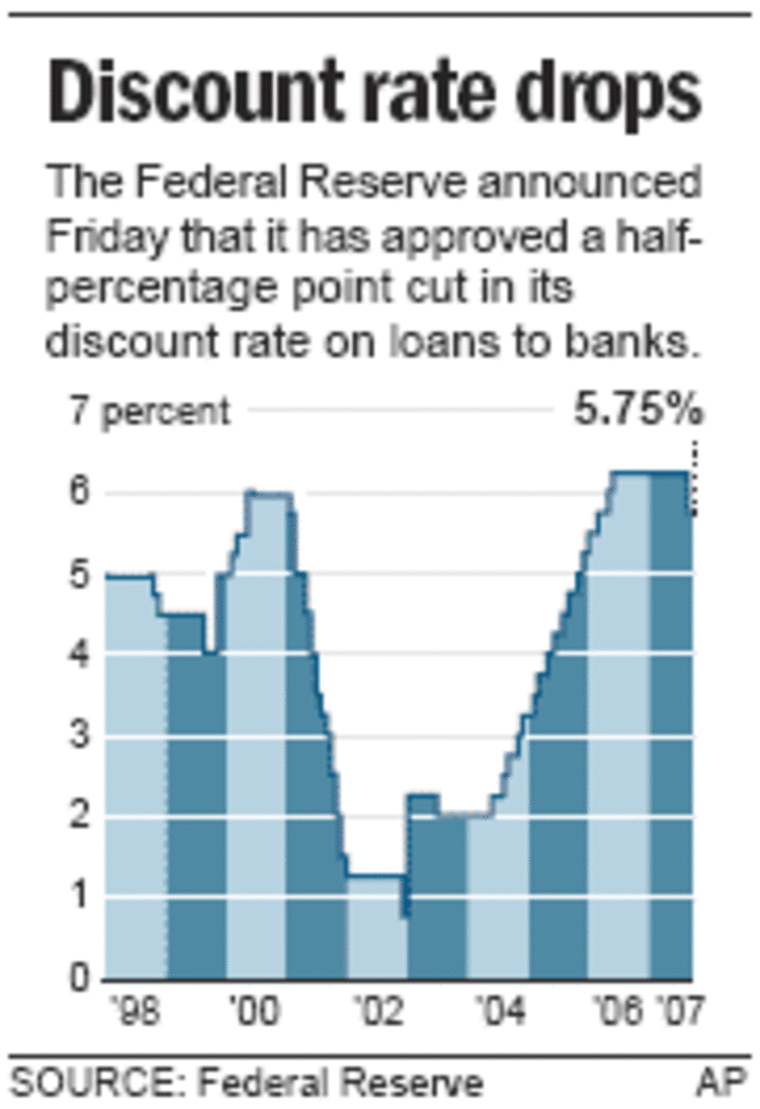The Federal Reserve approved a half-percentage point cut in its discount rate on loans to banks Friday, a dramatic move designed to stabilize financial markets roiled by a widening credit crisis.
The action sent stocks soaring, with the Dow Jones industrial average up more than 300 points right after the opening bell. The blue chip index finished the day up 233.30 points at 13,079.08.
The decision means that the discount rate, the interest rate the Fed charges to make direct loans to banks, will be lowered from 6.25 percent down to 5.75 percent.
The Fed did not change its target for the more important federal funds rate, which has remained at 5.25 percent for more than a year, but it sent a strong signal in the wording of its statement that it was prepared to cut that rate as well.
It did that by dropping any reference to inflation, which was the worry that previously had kept it from cutting the federal funds rate, and instead stated that “the downside risks to growth have increased appreciably.”
Many economists said the move from an emphasis on inflation worries to an emphasis on worries about economic growth is the precursor to an actual cut in rates, probably at the next regular Fed meeting on Sept. 18.

“They provided a much needed response to the growing market turmoil today, but they will have to do more,” said Mark Zandi, chief economist at Moody’s Economy.com.
Some analysts said the funds rate would be cut at least twice before the end of the year while others predicted the Fed would cut the funds rate by a quarter point at each of its remaining meetings in September, October and December if the risks of an economic slowdown keep growing.
The move to cut the discount rate will not have a major impact on consumer interest rates in the way that cutting the federal funds rate triggers an immediate drop in banks’ prime lending rate, the benchmark for millions of consumer and business loans.
However, Friday’s move was expected to help with a severe cash crunch facing many businesses, including mortgage companies, which are having trouble getting loans for short-term financing needs.
In a statement explaining the action, the Fed said that while incoming data suggest the economy is continuing to expand at a moderate pace, “the downside risks to growth have increased appreciably.”
The Fed said it was “monitoring the situation and is prepared to act as needed to mitigate the adverse effects on the economy arising from the disruptions in financial markets.”
It also said that “financial market conditions have deteriorated and tighter credit conditions and increased uncertainty have the potential to restrain economic growth going forward.”
The discount rate cut was approved by the Fed’s board, which controls this rate. However the policy statement was approved unanimously by the Federal Open Market Committee, the larger group of Fed board members in Washington and Fed regional bank presidents who set the federal funds rate.
Economists saw that as a significant signal that the Fed stood ready to cut the funds rate, which has been at 5.25 percent since June 2006 when the Fed ended a two-year rate tightening campaign aimed at slowing economic growth enough to keep inflation under control.
The discount rate covers only loans that the Fed makes directly to banks. By moving it to 5.75 percent, the Fed put it closer to the funds rate. The central bank also announced other technical changes to make it easier for banks to get discount loans, such as extending the time the credit will be supplied to up to 30 days.
The nation’s once high-flying housing market has been sinking deeper into gloom, and credit, the economy’s lifeblood, is drying up. Many economists believe these problems, including declining consumer confidence, could lead to a recession.
Since setting a record close of 14,000.41 just a month ago, the Dow Jones industrial average has shed 1,154.63 points in a string of triple-digit losing days that have raised anxiety levels not just on Wall Street but on Main Street as well.
The markets have been pummeled by a rapidly spreading credit crisis that began with rising defaults in subprime mortgages — home loans made to people with weak credit histories. Now the problems are spreading to other borrowers.
Countrywide Financial Corp., the nation’s largest mortgage banker, was forced to borrow $11.5 billion Thursday so it could keep making home loans. It was a move that rattled investors who have watched a number of smaller mortgage companies go under because of credit problems.
The shockwaves have extended to giant Wall Street investment firms such as Goldman Sachs, which announced earlier this week that it was pumping $2 billion into one of its struggling hedge funds and was asking other investors put to put in another $1 billion. BNP Paribas, France’s largest bank, last week froze three funds that had invested in the troubled U.S. mortgage market.
The Fed and other central banks already had infused the banking system with billions of dollars in an effort to keep short-term interest rates from surging and making credit even more difficult to obtain.
However, those billions did not calm investors worried about which big hedge fund or mortgage company will be the next to announce serious problems. For that reason, investors have become fearful to supply money through credit markets to companies even if they have strong credit records.